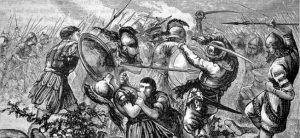The March of the Ten Thousand is chronicled by Athenian historian Xenophon in his book the “Anabasis” which literally translates to the “The March up-country”.
The Ten Thousand was a Greek mercenary division comprised of Ten Thousand men who joined the rebellion of Prince Cyrus of Persia in 401 BC. Cyrus was rebelling against his brother, Artaxerxes, for control of the Persian Empire. With the 10,000 Greek soldiers and close to 100,000 native soldiers, Cyrus from Sardis marched 1,766 miles towards Babylon deep in the interior of the Persian Empire.

Ireland as Atlantis – Ancient Egyptian & Greek Clues
This resulted in the Battle of Cunaxa in 401 BC. Cyrus’ military was defeated and Cyrus himself was slain in the process. However, the Greeks were victorious on their flank. Unfortunately, they were winners on the losing side and when they were asked to surrender they refused; for they knew what surrendering to the Persians meant: slavery and slaughter.
Instead, the brave Greeks chose to march out of the Persian lands and back home to Greece in the east. The Ten Thousand were harried all the way on their long march back to Greece. Their route involved marching out of Babylon and towards the southern coast of the Black Sea.
Xenophon recorded that when the Greeks saw the sight of the sea they began to shout “Thalatta! Thalatta!”, meaning “The Sea! The Sea!”. Such a commotion made Xenophon and the rear guard believe that the front of the army was being attacked. The Black Sea was a sight of relief to the Greeks for it meant their long journey was coming to an end and they were back to their motherland. The Greeks would eventually rest at the city of Trapezus before finally returning to their homes.
Ask me anything
Explore related questions





